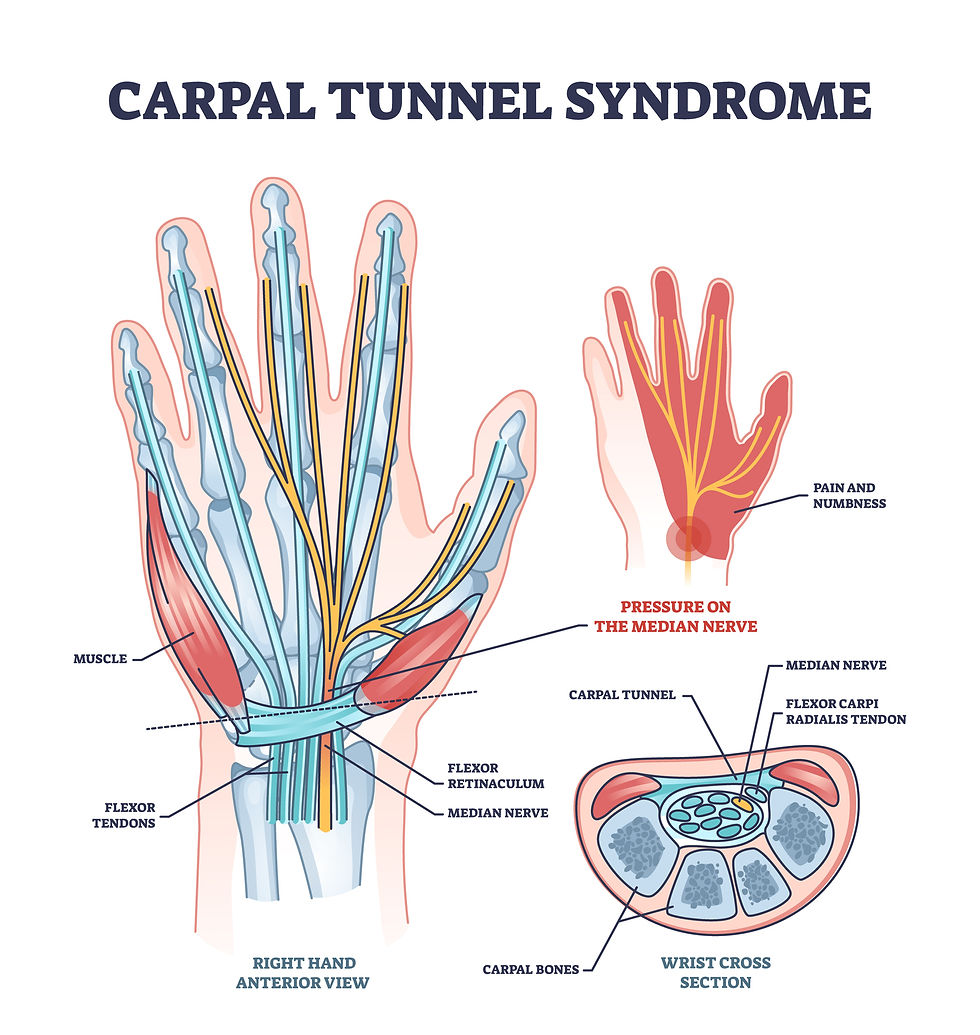What does Carpal Tunnel Feel Like?
- baysidehandtherapy
- Aug 5
- 3 min read
Understanding the Symptoms and when to Seek Help
If you have wrist pain, tingling or numbness in your hands, you might be wondering “is this carpal tunnel syndrome?” Carpal tunnel syndrome is a common condition, but there are many other conditions that can present with similar symptoms.
At Bayside Hand Therapy, we specialise in helping people understand and manage conditions affecting the hand, wrist and elbow. In this article, we’ll explain what carpal tunnel syndrome feels like, what causes it, and when it’s time to seek professional support.
What is Carpal Tunnel Syndrome?

Carpal tunnel syndrome happens when a nerve in your wrist—called the median nerve—gets compressed or irritated. This nerve runs through a narrow space in your wrist (the "carpal tunnel") and helps control feeling in parts of your hand. When there’s too much pressure on the nerve, it can lead to a range of symptoms.
Usually the first sign of carpal tunnel syndrome is waking in the morning or at night with tingling in your hand. This is because during sleep our wrists tend to bend which increases pressure within the carpal tunnel, reducing blood flow through the median nerve. You may feel like your hand is “falling asleep” or does not have enough blood flow. Rest assured the blood flow is not being cut off to your hand, only the blood flow through the median nerve is reduced. It may feel like the whole hand is tingling or numb but if you check carefully, the little finger should not be involved as it is supplied by a different nerve.
When carpal tunnel syndrome is mild, shaking the hand is often enough to restore blood flow through the nerve and feeling to the hand. If carpal tunnel syndrome becomes more severe you are likely to wake more frequently throughout the night with numbness or tingling and these symptoms may also occur intermittently during the day, typically during sustained activity such as gripping the steering wheel or holding a book or phone.
If carpal tunnel syndrome is very severe or long standing, you may develop constant numbness or tingling which continues throughout the day and night. You may find you are dropping things due to an inability to feel with your fingertips. You may also experience pain which radiates from your wrist into your fingers and in some cases pain may even refer up your arm.
Wrist pain without any pins and needles in the fingers is not a very common way for carpal tunnel syndrome to present, but does sometimes occur, especially in younger adults. Wrist pain from carpal tunnel syndrome is usually felt in the midline of the wrist. If your pain is in another part of your wrist, it is likely to be a different condition causing your pain.
How Can a Hand Therapist Help?
As a hand therapy clinic specialising in wrist and hand conditions, we see many clients with carpal tunnel symptoms. We can help by:
Confirming whether you have carpal tunnel syndrome or a different condition
Providing the most effective splint options to support your wrist at night
Guiding you through gentle exercises
Suggesting practical changes to reduce stress on your wrists during the day
In some cases, we’ll work alongside your GP or specialist if further treatment—like imaging or surgery—is needed.
When Should you Seek Help?
If you’ve been experiencing hand or wrist symptoms for more than a few weeks—or if they’re affecting your sleep or daily activities—it’s worth having them checked.
As with all medical conditions, addressing carpal tunnel syndrome early leads to better outcomes.






Comments